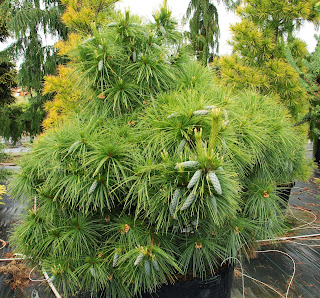Written by Dennis Lee, the following excerpted descriptions and photos are from the ACS's Fall 2013 Conifer Quarterly.
 |
| Pinus x schwerinii ‘Wiethorst’ Photo: Sam Pratt |
 |
| Pinus x schwerinii ‘Wiethorst’ Photo: Sam Pratt |
Pinus x schwerinii 'Wiethorst': In the 1980's a witch's broom* was found by a Mr. Wieting of Gieelhorst, Germany. Although many brooms have dwarf growth characteristics, 'Wiethorst' is an intermediate form. On poorer sites it may produce 3-6 inches of new growth; under better conditions it may easily produce 6-8 inches of growth. It readily responds to candle pruning to help maintain a more compact size and shape. Candle pruning greatly reduces the growth rate and also creates a very compact, shaggy appearing 'Wiethorst.' If left on its own, it will assume a somewhat open, informal structure with billowy branches. In 10 years, it will likely be about 6-7 feet tall and 5-6 feet wide. 'Wiethorst' performs well in USDA Zones 4-7 situated in sun to part-shade.
Heavy cone production and interesting cone presentation are other attributes of 'Wiethorst'. Small, stiff, first-year cones are prominently displayed in an outward manner on short stalks. Second-year cones are gray-green, curved and often dripping with sap. The greenish-blue needles are streaked with silver and may exceed nine inches in length. Because they are thin, the needles sway in a breeze for a nice effect.
 |
| Abies koreana ‘Kohouts Icebreaker’ Photo: Dennis Lee |
Both 'Wiethorst' and 'Kohouts Icebreaker' are cold hardy, but not adaptable for the deep south of the U.S.
Active members of ACS are able to order one or both of these special conifers. To read more about these garden-worthy conifers, link to an order form, or become an ACS member, click here.
Another potential plant source for the conifers is Conifer Kingdom, an Oregon specialty nursery.
*Witch's brooms are tightly congested formations of twigs and foliage in a parent tree. If a broom is a genetic mutation, rather than the result of a pest, the characteristics of the broom can be propagated.
 |
| A witch’s broom. Photo: utahpests.usu.edu |

No comments:
Post a Comment